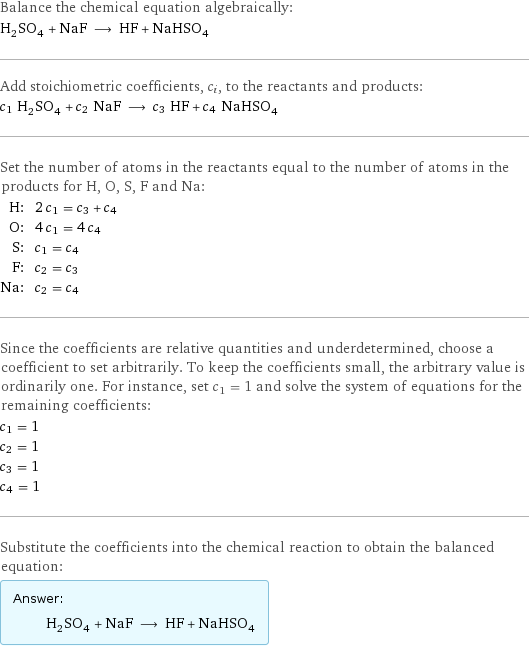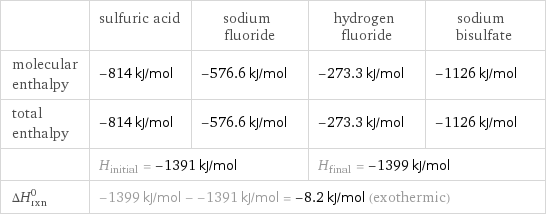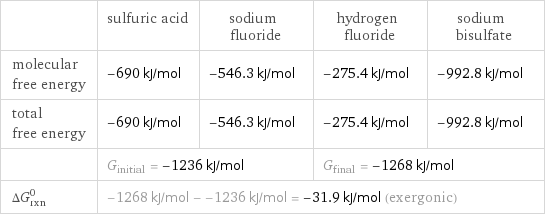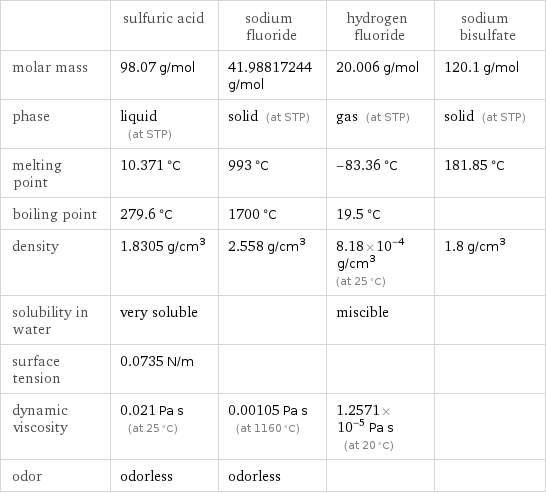Input interpretation

H_2SO_4 sulfuric acid + NaF sodium fluoride ⟶ HF hydrogen fluoride + NaHSO_4 sodium bisulfate
Balanced equation

Balance the chemical equation algebraically: H_2SO_4 + NaF ⟶ HF + NaHSO_4 Add stoichiometric coefficients, c_i, to the reactants and products: c_1 H_2SO_4 + c_2 NaF ⟶ c_3 HF + c_4 NaHSO_4 Set the number of atoms in the reactants equal to the number of atoms in the products for H, O, S, F and Na: H: | 2 c_1 = c_3 + c_4 O: | 4 c_1 = 4 c_4 S: | c_1 = c_4 F: | c_2 = c_3 Na: | c_2 = c_4 Since the coefficients are relative quantities and underdetermined, choose a coefficient to set arbitrarily. To keep the coefficients small, the arbitrary value is ordinarily one. For instance, set c_1 = 1 and solve the system of equations for the remaining coefficients: c_1 = 1 c_2 = 1 c_3 = 1 c_4 = 1 Substitute the coefficients into the chemical reaction to obtain the balanced equation: Answer: | | H_2SO_4 + NaF ⟶ HF + NaHSO_4
Structures

+ ⟶ +
Names

sulfuric acid + sodium fluoride ⟶ hydrogen fluoride + sodium bisulfate
Reaction thermodynamics
Enthalpy

| sulfuric acid | sodium fluoride | hydrogen fluoride | sodium bisulfate molecular enthalpy | -814 kJ/mol | -576.6 kJ/mol | -273.3 kJ/mol | -1126 kJ/mol total enthalpy | -814 kJ/mol | -576.6 kJ/mol | -273.3 kJ/mol | -1126 kJ/mol | H_initial = -1391 kJ/mol | | H_final = -1399 kJ/mol | ΔH_rxn^0 | -1399 kJ/mol - -1391 kJ/mol = -8.2 kJ/mol (exothermic) | | |
Gibbs free energy

| sulfuric acid | sodium fluoride | hydrogen fluoride | sodium bisulfate molecular free energy | -690 kJ/mol | -546.3 kJ/mol | -275.4 kJ/mol | -992.8 kJ/mol total free energy | -690 kJ/mol | -546.3 kJ/mol | -275.4 kJ/mol | -992.8 kJ/mol | G_initial = -1236 kJ/mol | | G_final = -1268 kJ/mol | ΔG_rxn^0 | -1268 kJ/mol - -1236 kJ/mol = -31.9 kJ/mol (exergonic) | | |
Equilibrium constant
![Construct the equilibrium constant, K, expression for: H_2SO_4 + NaF ⟶ HF + NaHSO_4 Plan: • Balance the chemical equation. • Determine the stoichiometric numbers. • Assemble the activity expression for each chemical species. • Use the activity expressions to build the equilibrium constant expression. Write the balanced chemical equation: H_2SO_4 + NaF ⟶ HF + NaHSO_4 Assign stoichiometric numbers, ν_i, using the stoichiometric coefficients, c_i, from the balanced chemical equation in the following manner: ν_i = -c_i for reactants and ν_i = c_i for products: chemical species | c_i | ν_i H_2SO_4 | 1 | -1 NaF | 1 | -1 HF | 1 | 1 NaHSO_4 | 1 | 1 Assemble the activity expressions accounting for the state of matter and ν_i: chemical species | c_i | ν_i | activity expression H_2SO_4 | 1 | -1 | ([H2SO4])^(-1) NaF | 1 | -1 | ([NaF])^(-1) HF | 1 | 1 | [HF] NaHSO_4 | 1 | 1 | [NaHSO4] The equilibrium constant symbol in the concentration basis is: K_c Mulitply the activity expressions to arrive at the K_c expression: Answer: | | K_c = ([H2SO4])^(-1) ([NaF])^(-1) [HF] [NaHSO4] = ([HF] [NaHSO4])/([H2SO4] [NaF])](../image_source/4ceba454b008a0d1cfd0160c26cde4c7.png)
Construct the equilibrium constant, K, expression for: H_2SO_4 + NaF ⟶ HF + NaHSO_4 Plan: • Balance the chemical equation. • Determine the stoichiometric numbers. • Assemble the activity expression for each chemical species. • Use the activity expressions to build the equilibrium constant expression. Write the balanced chemical equation: H_2SO_4 + NaF ⟶ HF + NaHSO_4 Assign stoichiometric numbers, ν_i, using the stoichiometric coefficients, c_i, from the balanced chemical equation in the following manner: ν_i = -c_i for reactants and ν_i = c_i for products: chemical species | c_i | ν_i H_2SO_4 | 1 | -1 NaF | 1 | -1 HF | 1 | 1 NaHSO_4 | 1 | 1 Assemble the activity expressions accounting for the state of matter and ν_i: chemical species | c_i | ν_i | activity expression H_2SO_4 | 1 | -1 | ([H2SO4])^(-1) NaF | 1 | -1 | ([NaF])^(-1) HF | 1 | 1 | [HF] NaHSO_4 | 1 | 1 | [NaHSO4] The equilibrium constant symbol in the concentration basis is: K_c Mulitply the activity expressions to arrive at the K_c expression: Answer: | | K_c = ([H2SO4])^(-1) ([NaF])^(-1) [HF] [NaHSO4] = ([HF] [NaHSO4])/([H2SO4] [NaF])
Rate of reaction
![Construct the rate of reaction expression for: H_2SO_4 + NaF ⟶ HF + NaHSO_4 Plan: • Balance the chemical equation. • Determine the stoichiometric numbers. • Assemble the rate term for each chemical species. • Write the rate of reaction expression. Write the balanced chemical equation: H_2SO_4 + NaF ⟶ HF + NaHSO_4 Assign stoichiometric numbers, ν_i, using the stoichiometric coefficients, c_i, from the balanced chemical equation in the following manner: ν_i = -c_i for reactants and ν_i = c_i for products: chemical species | c_i | ν_i H_2SO_4 | 1 | -1 NaF | 1 | -1 HF | 1 | 1 NaHSO_4 | 1 | 1 The rate term for each chemical species, B_i, is 1/ν_i(Δ[B_i])/(Δt) where [B_i] is the amount concentration and t is time: chemical species | c_i | ν_i | rate term H_2SO_4 | 1 | -1 | -(Δ[H2SO4])/(Δt) NaF | 1 | -1 | -(Δ[NaF])/(Δt) HF | 1 | 1 | (Δ[HF])/(Δt) NaHSO_4 | 1 | 1 | (Δ[NaHSO4])/(Δt) (for infinitesimal rate of change, replace Δ with d) Set the rate terms equal to each other to arrive at the rate expression: Answer: | | rate = -(Δ[H2SO4])/(Δt) = -(Δ[NaF])/(Δt) = (Δ[HF])/(Δt) = (Δ[NaHSO4])/(Δt) (assuming constant volume and no accumulation of intermediates or side products)](../image_source/e243a837afcf5b49fa75d4eaefd51807.png)
Construct the rate of reaction expression for: H_2SO_4 + NaF ⟶ HF + NaHSO_4 Plan: • Balance the chemical equation. • Determine the stoichiometric numbers. • Assemble the rate term for each chemical species. • Write the rate of reaction expression. Write the balanced chemical equation: H_2SO_4 + NaF ⟶ HF + NaHSO_4 Assign stoichiometric numbers, ν_i, using the stoichiometric coefficients, c_i, from the balanced chemical equation in the following manner: ν_i = -c_i for reactants and ν_i = c_i for products: chemical species | c_i | ν_i H_2SO_4 | 1 | -1 NaF | 1 | -1 HF | 1 | 1 NaHSO_4 | 1 | 1 The rate term for each chemical species, B_i, is 1/ν_i(Δ[B_i])/(Δt) where [B_i] is the amount concentration and t is time: chemical species | c_i | ν_i | rate term H_2SO_4 | 1 | -1 | -(Δ[H2SO4])/(Δt) NaF | 1 | -1 | -(Δ[NaF])/(Δt) HF | 1 | 1 | (Δ[HF])/(Δt) NaHSO_4 | 1 | 1 | (Δ[NaHSO4])/(Δt) (for infinitesimal rate of change, replace Δ with d) Set the rate terms equal to each other to arrive at the rate expression: Answer: | | rate = -(Δ[H2SO4])/(Δt) = -(Δ[NaF])/(Δt) = (Δ[HF])/(Δt) = (Δ[NaHSO4])/(Δt) (assuming constant volume and no accumulation of intermediates or side products)
Chemical names and formulas

| sulfuric acid | sodium fluoride | hydrogen fluoride | sodium bisulfate formula | H_2SO_4 | NaF | HF | NaHSO_4 Hill formula | H_2O_4S | FNa | FH | HNaO_4S name | sulfuric acid | sodium fluoride | hydrogen fluoride | sodium bisulfate
Substance properties

| sulfuric acid | sodium fluoride | hydrogen fluoride | sodium bisulfate molar mass | 98.07 g/mol | 41.98817244 g/mol | 20.006 g/mol | 120.1 g/mol phase | liquid (at STP) | solid (at STP) | gas (at STP) | solid (at STP) melting point | 10.371 °C | 993 °C | -83.36 °C | 181.85 °C boiling point | 279.6 °C | 1700 °C | 19.5 °C | density | 1.8305 g/cm^3 | 2.558 g/cm^3 | 8.18×10^-4 g/cm^3 (at 25 °C) | 1.8 g/cm^3 solubility in water | very soluble | | miscible | surface tension | 0.0735 N/m | | | dynamic viscosity | 0.021 Pa s (at 25 °C) | 0.00105 Pa s (at 1160 °C) | 1.2571×10^-5 Pa s (at 20 °C) | odor | odorless | odorless | |
Units
